 |
| Home for Bats, Raccoons, Squirrels, Bat's or Raccoon's Feces (Guano) Removal. |
| Zip Code Area Serviced |
| Counties We Provide Service For |
| About Us and Contact Info |
| Bats Found in Ohio |
| Bat Exclusion |
| Guano Removal aka Bat (Feces) Poop |
| Opossums Information on Size, Breeding, Habits, and Diseases |
| Raccoons, Habits, Breeding, Size, Raccoon Diseases, Raccoon Trapping |
| Skunks, Odors, Habit, Breeding, Size, Trapping |
| Squirrels, Squirrel Diseases, Removal, Habits |
| Beavers |
| Chimney & Deck Screening |
| Trapping |
| Common Questions Asked |
| Cats, Dogs and Your Local Wardens |
| Do Repellents Really Work?? |
| My Family's 1st WildlifeTrapper & Home Owner's Insurance |
| Info On Raccoons, Bats, Squirrels, Etc..,Size, Weight, Breeding, Etc... |
| Bats Myths or Facts |
| Infectious Diseases of Wildlife |
| "Ken Kritter Korner" |
| NEW SERVICE Bees and Hives Info |
|
|
 |
|
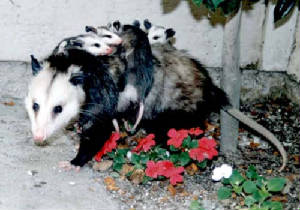
The Virginia Opossum (Didelphis virginiana),
commonly known as the North American Opossum, is the only marsupial found in North America north of the Rio Grande. A solitary and nocturnal
animal about the size of a domestic cat, it is a successful opportunist and is found throughout
Central
America and North America east of the Rockies from Costa Rica to southern Ontario (it was also introduced to California in 1910, and now occupies much of the Pacific coast); it seems to be still expanding
its range northward. Its ancestors evolved in South America, but were enabled to invade North America in the Great American
Interchange by the formation of the Isthmus
of Panama about 3 million years ago. It is often seen near towns, rummaging through garbage cans,
or lying by the side of the road, a victim
of traffic.
The Virginia Opossum is the original
animal named "opossum". The word comes from Algonquian 'wapathemwa' meaning "white animal", not from Greek or Latin, so the plural is opossums. Colloquially, the Virginia Opossum is frequently called
simply possum. The name is applied more generally to any of the other marsupials of the Didelphimorphia and Paucituberculata orders, which includes a number of opossum species in South America.
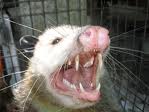
A very large Virginia Opossum baring
its sharp teeth and lips, making it appear quite vicious. It is the largest member of its genus, family and order and is the
largest of the opossums. They are typically 15–20 inches (38–51 cm) long and weigh between 9 and 13 pounds (4–6 kg). Their coats are a dull grayish brown, other than on their faces, which are white.
Opossums have long, hairless, prehensile tails, which can be used to grab branches and carry small objects. They also have hairless
ears and a long, flat nose. Opossums have 50 teeth and opposable, clawless thumbs on their rear limbs. Opossums have thirteen nipples, arranged in a circle of twelve with one in the middle.
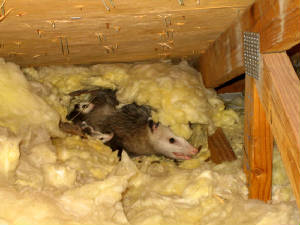
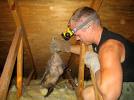

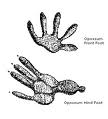
Opossum feet showing opposable "thumb" on back foot. Virginia Opossum tracks generally show five finger-like
toes in both the fore and hind prints. The hind tracks are unusual and distinctive due to the opossum's opposable thumb, which generally prints at an angle of 90 degrees or greater to the other fingers (sometimes
near 180 degrees). Individual adult tracks generally measure 1⅞ inches long by 2 inches wide (4.8 × 5.1 cm) for the
fore prints and 2½ inches long by 2¼ inches wide (6.4 × 5.7 cm) for the hind prints. Opossums have claws on all fingers fore
and hind except on the two thumbs, claw marks show as small holes just beyond the tip of each finger); these generally show
in the tracks.
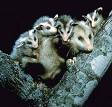
An Virginia opossum female may have as many as 25 babies, but she usually will have between seven to eight. The reason
opossums have so many babies to insure that some of them survive. Like most marsupials, opossums are very small when they
are born - about the size of a navy bean. Opossums have thirteen nipples, arranged in a circle of twelve with one in the middle. The babies climb up the mother's fur and into her pouch where
they find a teat. Some babies will not find their way to the pouch and will die. If they make it to the pouch, only babies
who find one of the thirteen teats will survive. They will stay in the pouch and suckle for 55-60 days. Then they will move
out of the pouch and spend another four to six weeks on their mother's back. In some parts of their range, females will have
three litters a year.
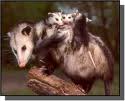
Opossum carry diseases such as leptospirosis, tuberculosis, relapsing fever,
tularemia, spotted fever, toxoplasmosis, coccidiosis, trichomoniasis, and Chagas disease. They may also be infested with fleas,
ticks, mites, and lice. Opossum are hosts for cat and dog fleas, especially in urban environments. To deter opossums an array of chemical products
is marketed for repelling various wildlife species but, unfortunately, none offer significant results. The odor of mothballs
or naphthalene crystals, used as a home remedy repellent, has occasionally been reported to be successful in driving opossum
from confined areas, but can build up toxicity in the soil. There are no registered toxicants for poisoning opossum. Poison
baits sold for the control of rodents should never be used in an attempt to control opossum, skunks, or raccoons. The penalty
for such pesticide misuse can be substantial and the practice usually becomes known as a result of the accidental poisoning
of someone's pet.
|
 |
If you have a wildlife problem, such as an opossum OR ANY WILDLIFE , it best be handled by a professional
firm, such as ourselves. Then, and only then, can you have peace of mind that that neither yourself or family member will
be bitten or injured and if required a biological cleanup will be done properly if needed.
Click Here For A Chart Of Diseases You Might Contract From Wildlife
|
 |
|
|
 |
|
|
 |
|
|
|
|
|
|
 |

